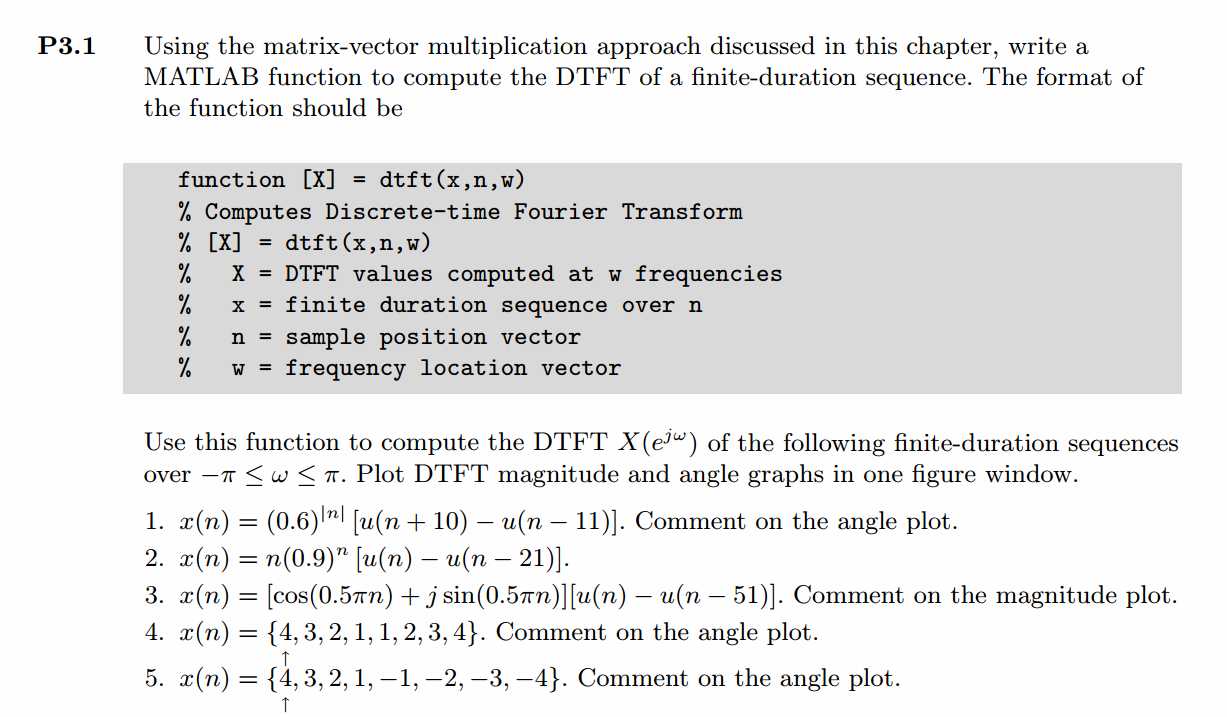
先写DTFT子函数:
function [X] = dtft(x, n, w) %% ------------------------------------------------------------------------ %% Computes DTFT (Discrete-Time Fourier Transform) %% of Finite-Duration Sequence %% Note: NOT the most elegant way % [X] = dtft(x, n, w) % X = DTFT values computed at w frequencies % x = finite duration sequence over n % n = sample position vector % w = frequency location vector M = 500; k = [-M:M]; % [-pi, pi] %k = [0:M]; % [0, pi] w = (pi/M) * k; X = x * (exp(-j*pi/M)) .^ (n‘*k); % X = x * exp(-j*n‘*pi*k/M) ;
下面开始利用上函数开始画图。结构都一样,先显示序列x(n),在进行DTFT,画出幅度响应和相位响应。
代码:
%% ------------------------------------------------------------------------ %% Output Info about this m-file fprintf(‘\n***********************************************************\n‘); fprintf(‘ <DSP using MATLAB> Problem 3.1 \n\n‘); banner(); %% ------------------------------------------------------------------------ % ---------------------------------- % x1(n) % ---------------------------------- n1_start = -11; n1_end = 13; n1 = [n1_start : n1_end]; x1 = 0.6 .^ (abs(n1)) .* (stepseq(-10, n1_start, n1_end)-stepseq(11, n1_start, n1_end)); figure(‘NumberTitle‘, ‘off‘, ‘Name‘, ‘Problem 3.1 x1(n)‘); set(gcf,‘Color‘,‘white‘); stem(n1, x1); xlabel(‘n‘); ylabel(‘x1‘); title(‘x1(n) sequence‘); grid on; M = 500; k = [-M:M]; % [-pi, pi] %k = [0:M]; % [0, pi] w = (pi/M) * k; [X1] = dtft(x1, n1, w); magX1 = abs(X1); angX1 = angle(X1); realX1 = real(X1); imagX1 = imag(X1); figure(‘NumberTitle‘, ‘off‘, ‘Name‘, ‘Problem 3.1 DTFT‘); set(gcf,‘Color‘,‘white‘); subplot(2,2,1); plot(w/pi, magX1); grid on; title(‘Magnitude Part‘); xlabel(‘frequency in \pi units‘); ylabel(‘Magnitude‘); subplot(2,2,3); plot(w/pi, angX1/pi); grid on; title(‘Angle Part‘); xlabel(‘frequency in \pi units‘); ylabel(‘Radians/\pi‘); subplot(‘2,2,2‘); plot(w/pi, realX1); grid on; title(‘Real Part‘); xlabel(‘frequency in \pi units‘); ylabel(‘Real‘); subplot(‘2,2,4‘); plot(w/pi, imagX1); grid on; title(‘Imaginary Part‘); xlabel(‘frequency in \pi units‘); ylabel(‘Imaginary‘); figure(‘NumberTitle‘, ‘off‘, ‘Name‘, ‘Problem 3.1 DTFT of x1(n)‘);; set(gcf,‘Color‘,‘white‘); subplot(2,1,1); plot(w/pi, magX1); grid on; title(‘Magnitude Part‘); xlabel(‘frequency in \pi units‘); ylabel(‘Magnitude‘); subplot(2,1,2); plot(w/pi, angX1); grid on; title(‘Angle Part‘); xlabel(‘frequency in \pi units‘); ylabel(‘Radians‘); % ------------------------------------- % x2(n) % ------------------------------------- n2_start = -1; n2_end = 22; n2 = [n2_start : n2_end]; x2 = (n2 .* (0.9 .^ n2)) .* (stepseq(0, n2_start, n2_end) - stepseq(21, n2_start, n2_end)); figure(‘NumberTitle‘, ‘off‘, ‘Name‘, ‘Problem 3.1 x2(n)‘); set(gcf,‘Color‘,‘white‘); stem(n2, x2); xlabel(‘n‘); ylabel(‘x2‘); title(‘x2(n) sequence‘); grid on; M = 500; k = [-M:M]; % [-pi, pi] %k = [0:M]; % [0, pi] w = (pi/M) * k; [X2] = dtft(x2, n2, w); magX2 = abs(X2); angX2 = angle(X2); realX2 = real(X2); imagX2 = imag(X2); figure(‘NumberTitle‘, ‘off‘, ‘Name‘, ‘Problem 3.1 DTFT of x2(n)‘);; set(gcf,‘Color‘,‘white‘); subplot(2,1,1); plot(w/pi, magX2); grid on; title(‘Magnitude Part‘); xlabel(‘frequency in \pi units‘); ylabel(‘Magnitude‘); subplot(2,1,2); plot(w/pi, angX2); grid on; title(‘Angle Part‘); xlabel(‘frequency in \pi units‘); ylabel(‘Radians‘); % ------------------------------------- % x3(n) % ------------------------------------- n3_start = -1; n3_end = 52; n3 = [n3_start : n3_end]; x3 = (cos(0.5*pi*n3) + j * sin(0.5*pi*n3)) .* (stepseq(0, n3_start, n3_end) - stepseq(51, n3_start, n3_end)); figure(‘NumberTitle‘, ‘off‘, ‘Name‘, ‘Problem 3.1 x3(n)‘); set(gcf,‘Color‘,‘white‘); stem(n3, x3); xlabel(‘n‘); ylabel(‘x3‘); title(‘x3(n) sequence‘); grid on; M = 500; k = [-M:M]; % [-pi, pi] %k = [0:M]; % [0, pi] w = (pi/M) * k; [X3] = dtft(x3, n3, w); magX3 = abs(X3); angX3 = angle(X3); realX3= real(X3); imagX3 = imag(X3); figure(‘NumberTitle‘, ‘off‘, ‘Name‘, ‘Problem 3.1 DTFT of x3(n)‘);; set(gcf,‘Color‘,‘white‘); subplot(2,1,1); plot(w/pi, magX3); grid on; title(‘Magnitude Part‘); xlabel(‘frequency in \pi units‘); ylabel(‘Magnitude‘); subplot(2,1,2); plot(w/pi, angX3); grid on; title(‘Angle Part‘); xlabel(‘frequency in \pi units‘); ylabel(‘Radians‘); % ------------------------------------- % x4(n) % ------------------------------------- n4_start = 0; n4_end = 7; n4 = [n4_start : n4_end]; x4 = [4:-1:1, 1:4]; figure(‘NumberTitle‘, ‘off‘, ‘Name‘, ‘Problem 3.1 x4(n)‘); set(gcf,‘Color‘,‘white‘); stem(n4, x4, ‘r‘, ‘filled‘); xlabel(‘n‘); ylabel(‘x4‘); title(‘x4(n) sequence‘); grid on; M = 500; k = [-M:M]; % [-pi, pi] %k = [0:M]; % [0, pi] w = (pi/M) * k; [X4] = dtft(x4, n4, w); magX4 = abs(X4); angX4 = angle(X4); realX4= real(X4); imagX4 = imag(X4); figure(‘NumberTitle‘, ‘off‘, ‘Name‘, ‘Problem 3.1 DTFT of x3(n)‘);; set(gcf,‘Color‘,‘white‘); subplot(2,1,1); plot(w/pi, magX4); grid on; title(‘Magnitude Part‘); xlabel(‘frequency in \pi units‘); ylabel(‘Magnitude‘); subplot(2,1,2); plot(w/pi, angX4); grid on; title(‘Angle Part‘); xlabel(‘frequency in \pi units‘); ylabel(‘Radians‘); % ------------------------------------- % x5(n) % ------------------------------------- n5_start = 0; n5_end = 7; n5 = [n5_start : n5_end]; x5 = [4:-1:1, -1:-1:-4]; figure(‘NumberTitle‘, ‘off‘, ‘Name‘, ‘Problem 3.1 x5(n)‘); set(gcf,‘Color‘,‘white‘); stem(n5, x5, ‘r‘, ‘filled‘); xlabel(‘n‘); ylabel(‘x5‘); title(‘x5(n) sequence‘); grid on; M = 500; k = [-M:M]; % [-pi, pi] %k = [0:M]; % [0, pi] w = (pi/M) * k; [X5] = dtft(x5, n5, w); magX5 = abs(X5); angX5 = angle(X5); realX5= real(X5); imagX5 = imag(X5); figure(‘NumberTitle‘, ‘off‘, ‘Name‘, ‘Problem 3.1 DTFT of x5(n)‘); set(gcf,‘Color‘,‘white‘); subplot(2,1,1); plot(w/pi, magX5); grid on; title(‘Magnitude Part‘); xlabel(‘frequency in \pi units‘); ylabel(‘Magnitude‘); subplot(2,1,2); plot(w/pi, angX5); grid on; title(‘Angle Part‘); xlabel(‘frequency in \pi units‘); ylabel(‘Radians‘);
运行结果:
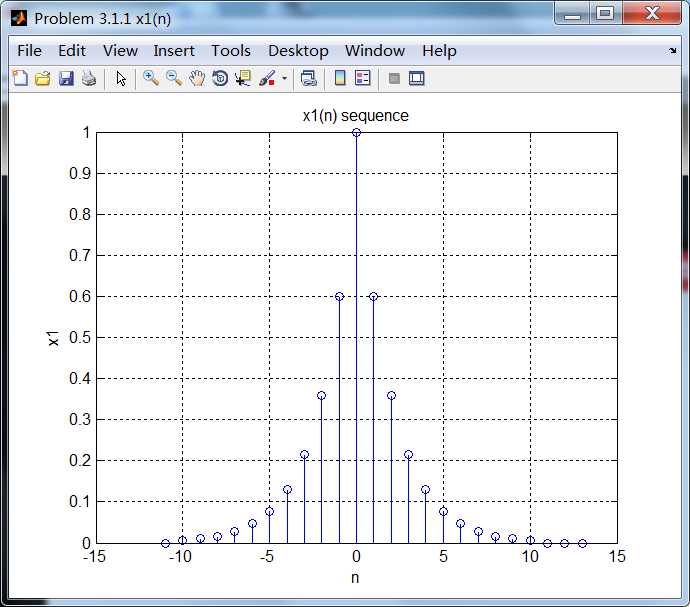
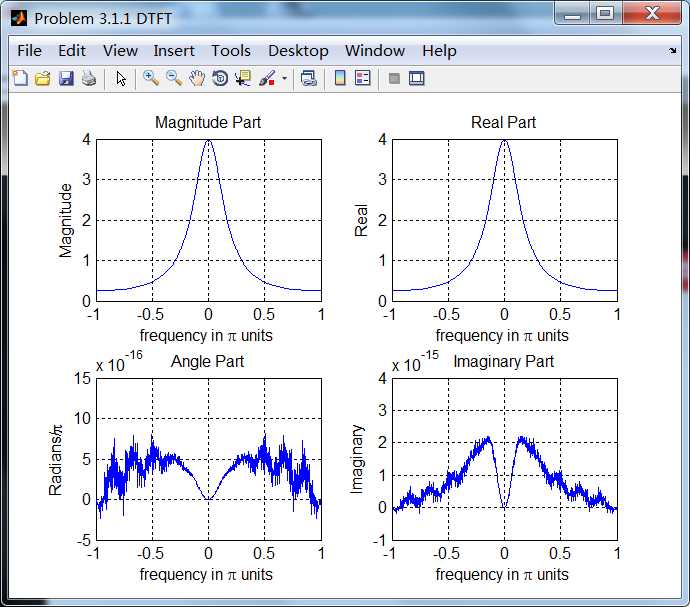
相位响应是关于ω=0偶对称的。
序列2:
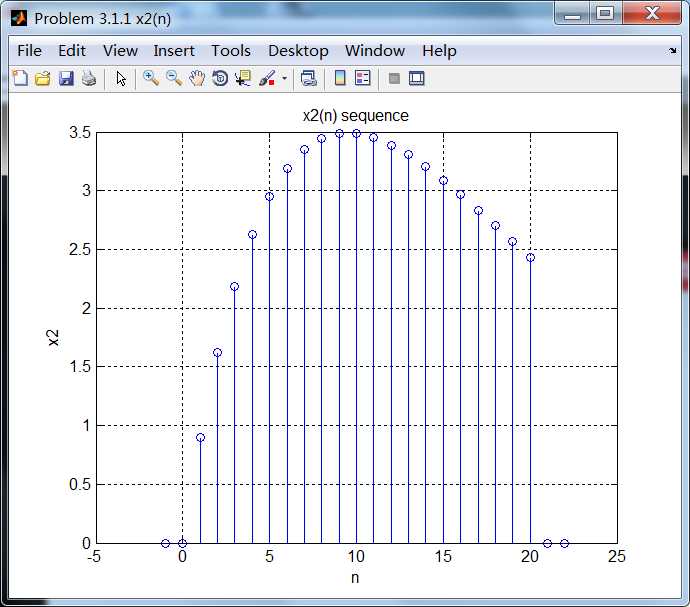

序列3:
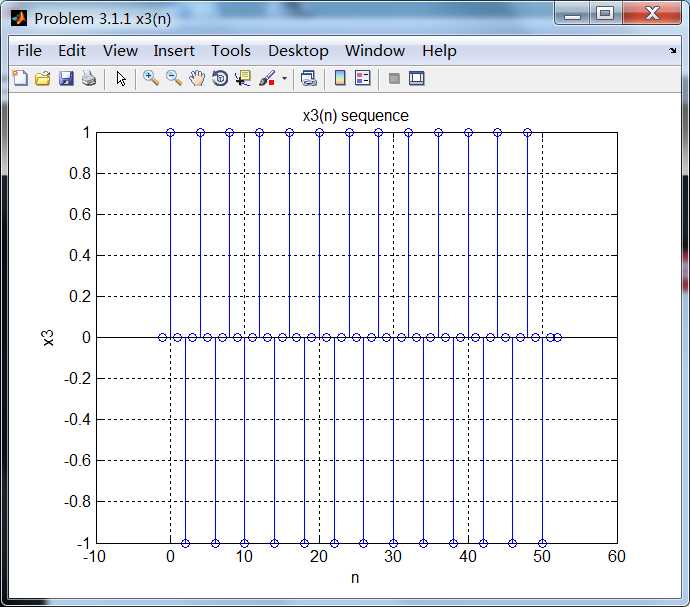
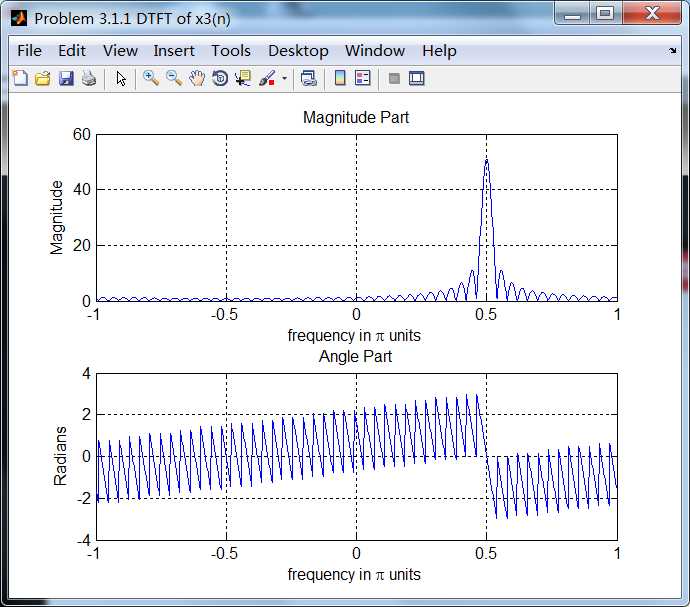
序列3的主要频率分量位于ω=0.5π。
序列4:
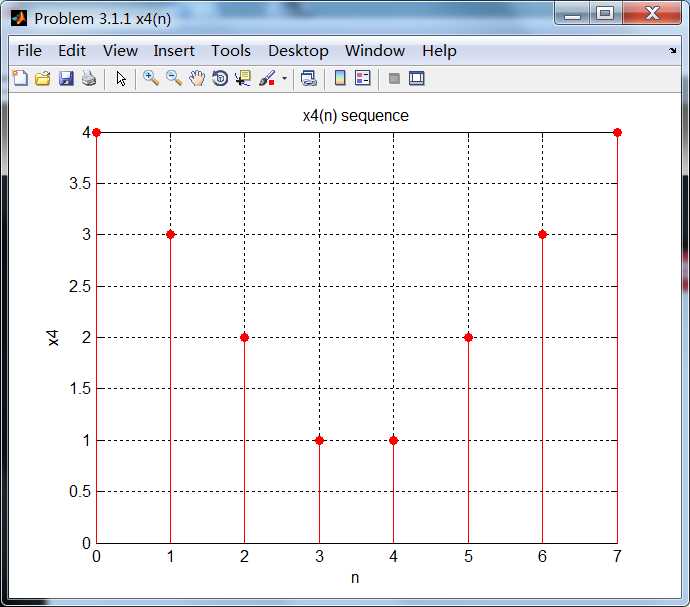
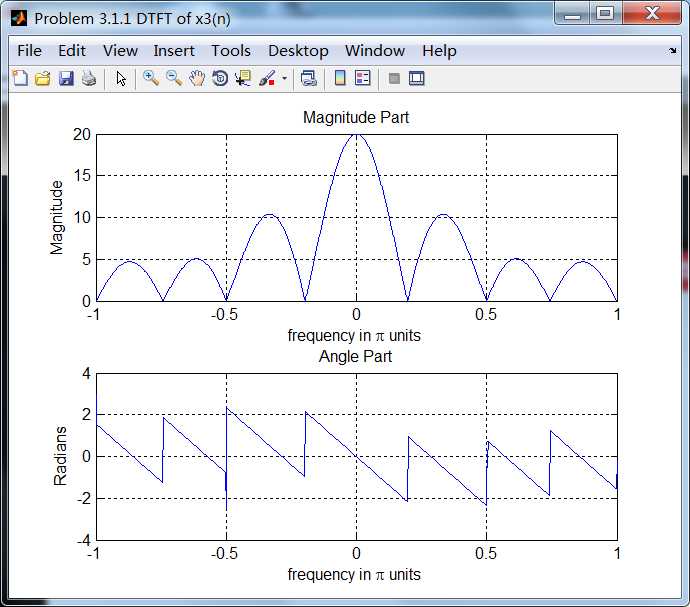
序列4的相位谱关于ω= 0奇对称。
序列5:
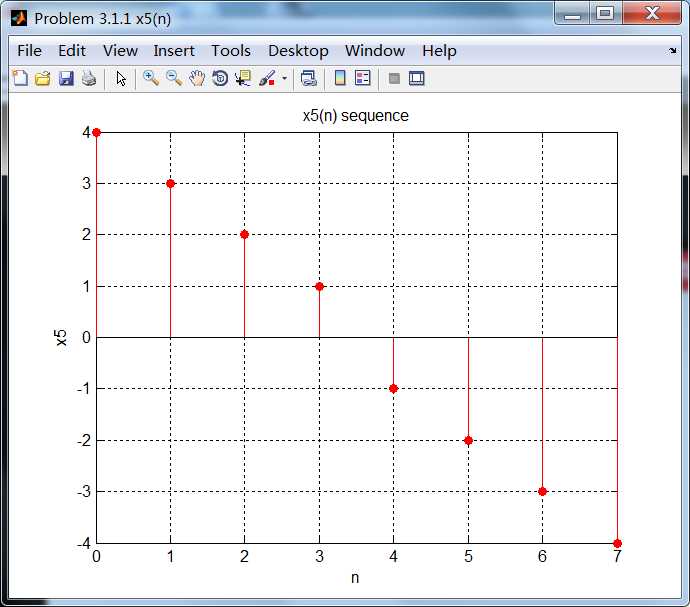
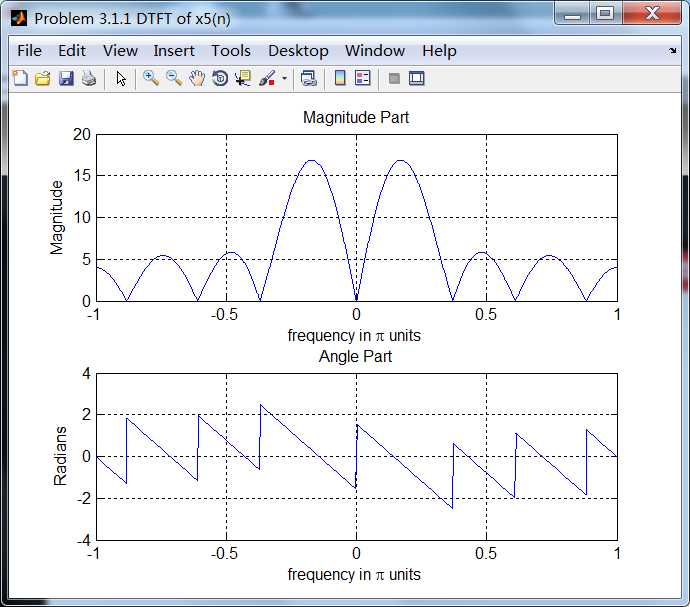
序列5的相位谱关于ω=0奇对称。
